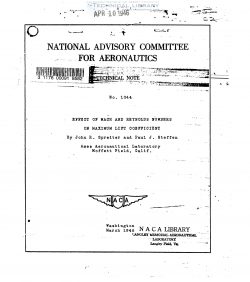naca-tn-1044
- Version
- 471 Downloads
- 1.57 MB File Size
- 1 File Count
- December 2, 2016 Create Date
- December 2, 2016 Last Updated
National Advisory Committee for Aeronautics, Technical Notes - Effect of Mach and Reynolds Numbers on Maximum Lift Coefficient

A knowlhdge of the effects of Mach and Reynolds numbers
on the maximum lift coefficient is becoming of greater impor-
tance as the speeds and altitudes attainable by modern air-
planes continually increase. Since most maximum—lift tests
conducted to date have been either at full— scale Reynolds
numbers and low Mach numbers or at high Mach numbers and
small Reynolds numbers, very little is known about the inter-
related effects of these two parameters on the maximum lift
coefficient, In order to obtain quantitative information on
these effects, flight tests were conducted at Ames Aeronauti—
cal Laboratory on six airplanes, three having NACA conven-
tional airfoil sections, two having NASA low~drag sections.
and the sixth having a North American Aviation — NAGA compr0v
misc low-drag section. The results of these tests which"
cover a range of Mach numbers frOm 0.15 to 0.72 and of Reynolds
numbers from 4,400,000 to 19,500,000 are assembled together
with a considerable quantity of pertinent wind—tunnel data,
and analyzed in the present report. From this analys_is, gen-
eral conclusions have been reached indicating the manner in
which the maximum lift coefficient is influenced by variations
of Mach and Reynolds numbers.
To afford a variety of commonly used airfoil sections,
and to permit correlation with existing Wind—tunnel results,
six particular pursuit- ~type airplanes were selected for the
flight~ test portion of this research. For convenience in » “HM
the presentation of the test results and the following disJ’
cussion, the type airplane and airplane model will be utilized
rather than the airfoil designation when referring to SP631f10
results. The aircraft used in the conduct of the flight tests
were the Bell B—EQN and PwESA airplanes, the Grumman Eerie
airplane, the Lockheed P—38F and YP-BOA airplanes, and the
North American P—SlB airplane.
| File | Action |
|---|---|
| naca-tn-1044 Effect of Mach and Reynolds Numbers on Maximum Lift Coefficient.pdf | Download |

Comment On This Post